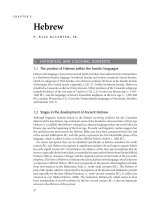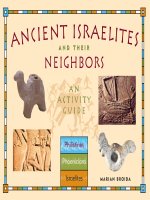Ancient storytelling
Bạn đang xem bản rút gọn của tài liệu. Xem và tải ngay bản đầy đủ của tài liệu tại đây (69.39 KB, 3 trang )
Ancient Storytelling
A. It was told, we suppose, to people crouched around a fire: a tale of adventure, most
likely- relating some close encounter with death; a remarkable hunt, an escape from
mortal danger; a vision, or something else out of the ordinary. Whatever its thread, the
weaving of this story was done with a prime purpose. The listeners must be kept
listening. They must not fall asleep. So, as the story went on, its audience should be
sustained by one question above all. What happens next?
B. The first fireside stories in human history can never be known. They were kept in the
heads of those who told them. This method of storage is not necessarily inefficient. From
documented oral traditions in Australia, the Balkans and other parts of the world we
know that specialised storytellers and poets can recite from memory literally thousands
of lines, in verse or prose, verbatim-word for word. But while memory is rightly
considered an art in itself, it is clear that a primary purpose of making symbols is to have
a system of reminders or mnemonic cues – signs that assist us to recall certain
information in the mind’s eye.
C. In some Polynesian communities, a notched memory stick may help to guide a
storyteller through successive stages of recitation. But in other parts of the world, the
activity of storytelling historically resulted in the development or even the invention of
writing systems. One theory about the arrival of literacy in ancient Greece, for example,
argues that the epic tales about the Trojan War and the wanderings of Odysseus –
traditionally attributed to Homer – were just so enchanting to hear that they had to be
preserved. So the Greeks, c.750-700BC, borrowed an alphabet from their neighbors in
the eastern Mediterranean, the Phoenicians.
D. The custom of recording stories on parchment and other materials can be traced in
many manifestations around the world, from the priestly papyrus archives of ancient
Egypt to the birch-bark scrolls on which the North American Ojibway Indians set down
their creation- myth. It is a well-tried and universal practice: so much so that to this day
storytime is probably most often associated with words on paper. The formal practice of
narrating a story aloud would seem-so we assume to have given way to newspapers,
novels and comic strips. This, however, is not the case. Statistically, it is doubtful that
the majority of humans currently rely upon the written word to get access to stories. So
what is the alternative source?
E. Each year, over 7 billion people will go to watch the latest offering from Hollywood,
Bollywood and beyond. The supreme storyteller of today is cinema. The movies, as
distinct from still photography, seem to be an essential modem phenomenon. This is an
illusion, for there are, as we shall see, certain ways in which the medium of film is
indebted to very old precedents of arranging ‘sequences’ of images. But any account of
visual storytelling must be with the recognition that all storytelling beats with a deeply
atavistic pulse: that is, a ‘good story’ relies upon formal patterns of plot and
characterisation that have been embedded in the practice of storytelling over many
generations.
F. Thousands of scripts arrive every week at the offices of the major film studios. But
aspiring screenwriters really need to look no further for essential advice then the fourthcentury BC Greek Philosopher Aristotle. He left some incomplete lecture notes on the art
of telling stories in various literary and dramatic modes, a slim volume known as The
Poetics. Though he can never have envisaged the popcorn-fuelled actuality of a multiplex
cinema, Aristotle is almost prescient about the key elements required to get the crowds
flocking to such a cultural hub. He analyzed the process with cool rationalism. When a
story enchants us, we lose the sense of where we are; we are drawn into the story so
thoroughly that we forget it is a story being told. This is, in Aristotle’s phrase, ‘the
suspension of disbelief.
G. We know the feeling. If ever we have stayed in our seats, stunned with grief, as the
credits roll by, or for days after seeing that vivid evocation of horror have been nervous
about taking a shower at home, then we have suspended disbelief. We have been
caught, or captivated, in the storyteller’s web. Did it all really happen? We really thought
so for a while. Aristotle must have witnessed often enough this suspension of disbelief.
He taught at Athens, the city where theater developed as a primary form of civic ritual
and recreation. Two theatrical types of storytelling, tragedy and comedy, caused
Athenian audiences to lose themselves in sadness and laughter respectively. Tragedy, for
Aristotle, was particularly potent in its capacity to enlist and then purge the emotions of
those watching the story unfold on the stage, so he tried to identify those factors in the
storyteller’s art that brought about such engagement. He had, as an obvious sample for
analysis, not only the fifth-century BC masterpieces of Classical Greek tragedy written by
Aeschylus, Sophocles and Euripides. Beyond them stood Homer, whose stories even then
had canonical status: The Iliad and The Odyssey were already considered literary
landmarks-stories by which all other stories should be measured. So what was the secret
of Homer’s narrative art?
H. It was not hard to find. Homer created credible heroes. His heroes belonged to the
past, they were mighty and magnificent, yet they were not, in the end, fantasy figures.
He made his heroes sulk, bicker, cheat and cry. They were, in short, characters –
protagonists of a story that an audience would care about, would want to follow, would
want to know what happens next. As Aristotle saw, the hero who shows a human sidesome flaw or weakness to which mortals are prone-is intrinsically dramatic.d by logging.
Questions 1-5
The Reading Passage has eight paragraphs A-H. Which paragraph contains the
following information? Write the correct letter A-H, in boxes 1-5 on your answer sheet.
1.................A misunderstanding of a modern way for telling stories
2.................The typical forms mentioned for telling stories
3.................The fundamental aim of storytelling
4.................A description of reciting stories without any assistance
5.................How to make story characters attractive
Questions 6-9 Classify the following information as referring to
A adopted the writing system from another country
B used organic materials to record stories
C used tools to help to tell stories
Write the correct letter, A, B or C in boxes 6-9 on your answer sheet.
6
Egyptians
7 Ojibway
8 Polynesians
9 Greek
Questions 10-13 Complete the sentences below with ONE WORD ONLY from the
passage.
Write your answer in boxes 10-13 on your answer sheet.
10 Aristotle wrote a book on the art of storytelling called 10.....................
11 Aristotle believed the most powerful type of story to move listeners is
11.....................
12 Aristotle viewed Homers works as 12.....................
13 Aristotle believed attractive heroes should have some 13.....................









